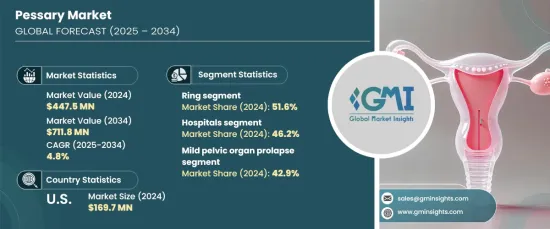PUBLISHER: Global Market Insights Inc. | PRODUCT CODE: 1665292

PUBLISHER: Global Market Insights Inc. | PRODUCT CODE: 1665292
Pessary Market Opportunity, Growth Drivers, Industry Trend Analysis, and Forecast 2025 - 2034
The Global Pessary Market was valued at USD 447.5 million in 2024 and is projected to experience steady growth at a CAGR of 4.8% from 2025 to 2034. This growth is primarily driven by the increasing prevalence of pelvic organ prolapse (POP) and urinary incontinence, heightened awareness about the importance of timely diagnosis and treatment, growing preference for non-invasive therapy options, and strengthened government initiatives supporting women's health programs.

The market is segmented by type, with the ring pessary leading the way, accounting for 51.6% of the market share in 2024. The ring pessary's continued dominance can be attributed to its versatility, ease of use, and lightweight comfort, making it ideal for individuals suffering from mild to moderate prolapse and stress urinary incontinence. Its design reduces irritation and allows for prolonged use, making it a favored choice in clinical settings and contributing to its widespread acceptance.
| Market Scope | |
|---|---|
| Start Year | 2024 |
| Forecast Year | 2025-2034 |
| Start Value | $447.5 Million |
| Forecast Value | $711.8 Million |
| CAGR | 4.8% |
By end user, hospitals emerged as the leading segment, capturing 46.2% of the market share in 2024. Hospitals play a pivotal role in diagnosing, managing, and treating pelvic floor disorders such as POP and stress urinary incontinence. These institutions offer both surgical and non-surgical pessary treatments, catering to patients with varying levels of severity. Their ability to handle complex cases and provide essential follow-up care further reinforces their dominance in the pessary market.
In the United States, the pessary market was valued at USD 169.7 million in 2024 and continues to show strong growth potential. The rise in pelvic disorders, alongside lifestyle-related health conditions like obesity, is driving the increasing demand for pessaries as effective, non-invasive treatment solutions. The expansion of healthcare access and ongoing efforts to raise awareness about pelvic health issues are contributing to the continued market growth across the country.
Table of Contents
Chapter 1 Methodology and Scope
- 1.1 Market scope and definitions
- 1.2 Research design
- 1.2.1 Research approach
- 1.2.2 Data collection methods
- 1.3 Base estimates and calculations
- 1.3.1 Base year calculation
- 1.3.2 Key trends for market estimation
- 1.4 Forecast model
- 1.5 Primary research and validation
- 1.5.1 Primary sources
- 1.5.2 Data mining sources
Chapter 2 Executive Summary
- 2.1 Industry 3600 synopsis
Chapter 3 Industry Insights
- 3.1 Industry ecosystem analysis
- 3.2 Industry impact forces
- 3.2.1 Growth drivers
- 3.2.1.1 Increasing prevalence of pelvic organ prolapse and urinary incontinence
- 3.2.1.2 Growing awareness towards timely diagnosis and treatment
- 3.2.1.3 Increasing adoption of non-invasive treatment options
- 3.2.1.4 Growing government support in women health programs
- 3.2.2 Industry pitfalls and challenges
- 3.2.2.1 Social stigma and psychological barrier
- 3.2.2.2 Concerns related to risk of infections due to prolonged use
- 3.2.1 Growth drivers
- 3.3 Growth potential analysis
- 3.4 Patent analysis
- 3.5 Gap analysis
- 3.6 Regulatory landscape
- 3.7 Technological landscape
- 3.8 Future market trends
- 3.9 Porter’s analysis
- 3.10 PESTEL analysis
Chapter 4 Competitive Landscape, 2024
- 4.1 Introduction
- 4.2 Company market share analysis
- 4.3 Competitive analysis of major market players
- 4.4 Competitive positioning matrix
- 4.5 Strategy outlook
Chapter 5 Market Estimates and Forecast, By Type, 2021 – 2034 ($ Mn)
- 5.1 Key trends
- 5.2 Ring
- 5.3 Donut
- 5.4 Gellhorn
- 5.5 Other types
Chapter 6 Market Estimates and Forecast, By Application, 2021 – 2034 ($ Mn)
- 6.1 Key trends
- 6.2 Mild pelvic organ prolapse
- 6.3 Stress urinary incontinence
- 6.4 Severe pelvic organ prolapse
- 6.5 Other applications
Chapter 7 Market Estimates and Forecast, By End Use, 2021 – 2034 ($ Mn)
- 7.1 Key trends
- 7.2 Hospitals
- 7.3 Ambulatory surgical centers
- 7.4 Clinics
- 7.5 Other end users
Chapter 8 Market Estimates and Forecast, By Region, 2021 – 2034 ($ Mn)
- 8.1 Key trends
- 8.2 North America
- 8.2.1 U.S.
- 8.2.2 Canada
- 8.3 Europe
- 8.3.1 Germany
- 8.3.2 UK
- 8.3.3 France
- 8.3.4 Spain
- 8.3.5 Italy
- 8.4 Asia Pacific
- 8.4.1 China
- 8.4.2 Japan
- 8.4.3 India
- 8.4.4 Australia
- 8.4.5 South Korea
- 8.5 Latin America
- 8.5.1 Brazil
- 8.5.2 Mexico
- 8.5.3 Argentina
- 8.6 Middle East and Africa
- 8.6.1 South Africa
- 8.6.2 Saudi Arabia
- 8.6.3 UAE
Chapter 9 Company Profiles
- 9.1 Artisan Medical
- 9.2 Bioteque America
- 9.3 Bliss GVS Pharma
- 9.4 Bray Group (Ethos Partners)
- 9.5 Coloplast Group
- 9.6 Contiform International
- 9.7 CooperSurgical
- 9.8 Dr. Arabin
- 9.9 Integra Lifesciences
- 9.10 MedGyn Products
- 9.11 Novomed group (Gyneas)
- 9.12 Panpac Medical
- 9.13 Personal Medical
- 9.14 Smiths Group
- 9.15 Sugar International




